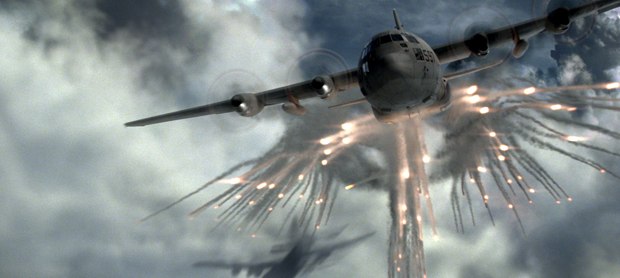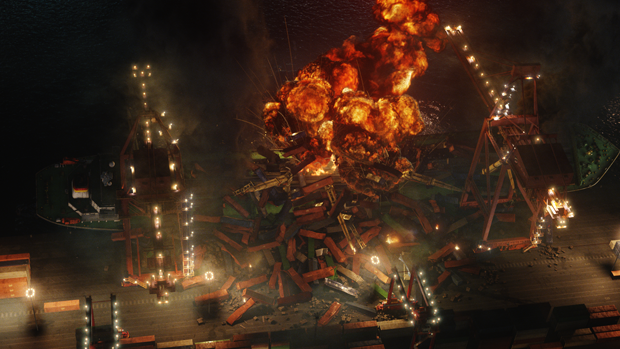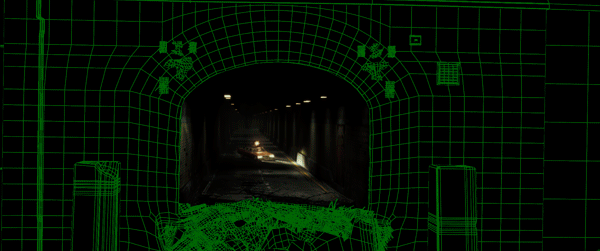Read how Rhythm & Hues, Weta, Digital Domain and Prime Focus came to the rescue of The A-Team.
Check out The A-Team trailer and clips at AWNtv!
For the Joe Carnahan-directed big screen version of The A-Team, James Price, the overall visual effects supervisor, recruited his own vfx A-Team comprised of Rhythm & Hues, Digital Domain, Weta Digital, Prime Focus, Hydraulx, Soho VFX and others. The mission: create the kind of mayhem associated with the popular '80s TV series -- only bring it up to date and make it explosive enough for the big screen.
Rhythm & Hues stepped in for the tank drop and Long Beach sequences. In the former, the A-Team tries to escape in a C130 being pursued by predator drones. Finally, one of the missiles hits and the plane explodes. But somehow the Team knew it was doomed and snuck into a tank that was in the cargo hold, so then it becomes a drop as the tank falls through space under parachute control with the predators still chasing them.
"It's the over-the-top A-Team stuff with vehicles," concedes Bill Westenhofer, visual effects supervisor for Rhythm & Hues. "It's all CG. We did digital cloud environments, the plane and the explosions. The cloud was the most technically challenging. We used a combination of Houdini and mantra for the clouds. That was the visibility calculation for bounding the shapes. And then once it determined we were in a cloud, we used our in-house volumetric rendering package, FELT.
"We had modeled in multi-scattering and other facets of clouds. The artists could shape the clouds, could run convection currents to cut different patterns and more complex things into shapes. In very specific cases, where planes are flying through, we changed our tables to have fluid dynamics affect the motion to get little vortices that get punched out through cloud banks and that sort of thing.
"We had some pre-baked cloud caches that you could position in space in the animation software to help the sense of speed by making sure there were clouds closer to the camera. There was a layout team that did an initial pass and then the animators took over and made adjustments to fit the action of the scene."
For lighting objects, they took advantage of the fact that the planes were small in relation to the environment and that it was a fully CG environment. "If you put a camera in the center of each of the planes and rendered a 360-degree panorama of the digital environment, we would use that to light the plane fairly efficiently," Westenhofer continues.
"So we used a global illuminationesque treatment without having to cast out rays for every part of the object. We used Houdini and our fluid solvers for when the plane explodes. We had some fun with the tracers. The effects artists had to do a little round of trying to lead the planes and aim the guns until they were firing where we wanted them to."
Westenhofer says the animation challenge was "addressing the insanity of it all." After all, the viewer has to buy the notion of a tank moving through space. They achieved this with clever use of camera angles.
As for the Long Beach sequence in which the A-Team rides into the harbor (shot in Vancouver) on a cargo ship and tries to scam the baddies, the tracking was difficult so they replaced the ocean with CG water. Rhythm & Hues also supplied a CG ship with 600 containers. The ship gets attacked by a shoulder rocket and starts spilling the containers onto the deck and lists off to the side. Meanwhile, the A-Team tries to ride the avalanche without getting crushed.
"During one of the late screenings, a Fox executive suggested adding secondary explosions," Westenhofer conveys. "Weta came in to handle that. We shared the assets of the ship and containers. For the containers and the avalanche they used rigid body simulation and built into the simulation the ability to crush, to some extent: for doors to open and contents to spill out. The simulated damage worked well for the mid to distant ground. For close ups we added more art-directed damage with hero containers."
According to Guy Williams, visual effects supervisor for Weta, they initially extended the backgrounds in the gun fight after the containers spill onto the dock. "To do this, we created 3D cranes and containers and dressed out the shots while adding in element layers for smoke, fire and debris," Williams explains. "As the scope of the scene grew, Weta was asked to help out with some of the ship shots. By the end, Weta had done most of the shots of the digital ship that involved large explosions or destruction. To do this, we started with an excellent model from R&H of the ship and the crane. This allowed our shots to cut seamlessly with the fine work coming from Bill Westenhofer and his guys at R&H. We fleshed out the environment with further builds of containers and dock dressing and light towers."
The Weta animation team under the leadership of Phillip Cramer animated all of the ship motion and reaction to the explosions as well as the flying containers that were blown into the air. "The FX team used Bullet to simulate smaller debris coming out of the flying containers," Williams continues. "Weta also added in fluid sim water to sit the ship in (and later to create large waves as the ship reacts to the explosions). The fluid sim software Weta used is Naiad. We also added in explosions using our solver and Maya's solver to sim the fireballs and then using our rendering system to render the proper temperatures into the fireballs Since everything (including the smoke plumes) was created in 3D, the lighting could be continuous. This means that a fireball would light up the ship, the smoke around the ship and the water all properly. This allowed us to create fully digital shots that felt more photographic and integrated. "
Digital Domain was responsible for a sequence in which the A-Team hijacks a cargo container on board a truck being guarded by a convoy of Hummers and a limo with a large mini-gun. At the end of the sequence, the truck and container fly through the air and crash into the Tigress River. Then they get rescued by Murdock (Sharlto Copeley) flying a V 22 Osprey, developed for multi-service combat operations.
"At the beginning, Jamie Price and his crew shot plates up in Vancouver, dressed for Bagdad and foreground bluescreen at a studio, and we put those two together," explains Kelly Port, visual effects supervisor at Digital Domain. "While the film was shot anamorphic, this sequence was shot spherical foreground and VistaVision background. That way we could adjust the plates to help with perspective and additional camera framing concerns.
"There are a couple of shots where we have a full-CG stunt double coming out of the sewer and magnetically attaching himself to the underside of the convoy truck. They fight the baddies on the truck and a big fire fight ensues and they're being chased by the limo with the gun hanging out it. The tunnel is full-CG and mixes with the Vista backgrounds because the original tunnel didn't work as planned.
"The truck crashes through some barricades that are CG and into the river. They shot a real truck crashing into the water in Vancouver and we added the cargo container and two digi doubles of Face [Bradley Cooper] and Hannibal [Liam Neeson] hanging on the outside the container. When it impacts the water, the airbags inflate and the cargo container floats, which is all-CG as well. We had to rotoscope the truck and extract that because it was the only usable part from the plate and then we recreated a concrete embankment. The plane shoots up the limo and it explodes, requiring more CG destruction and pyrotechnics, including a digi-double for the gunner collapsed bridge and broken up road.
"We had one shot of the container hitting the water but the perspective was from underwater, so we had to do some water simulation bubbles and the airbags impacting. It was a tricky balance to find the storytelling point, which was to find the airbags going off vs. the clarity of the water and the realism of that."
Digital Domain used Maya, RenderMan, Houdini and its proprietary fluid sim system.
The bulk of the work handled by Prime Focus Film VFX's Vancouver facility (under the supervision of Chris Harvey) included shots for the opening montage sequence of how the A-Team came together. This sequence involved a fiery pursuit scene and the A-Team's attempt to escape.
Prime Focus created particle-driven tracer fire, CG rockets, missiles and residual smoke. A number of aftermath elements were also generated, including water impact and rock debris CG simulations. Another sequence required the creation of a fully digital Bell 205 helicopter to replace the practical element in several shots. Prime Focus designed the helicopter to appear completely photo real. A fully rigged digi-double of B. A. Baracus (Quinton Jackson) was also inserted into this sequence along with rigged digi-doubles of other A-Team members. Matte paintings and synthetic skies completed the scene where practical photography would have been too challenging to capture.
The Prime Focus software toolkit included the proprietary Krakatoa for high-volume particle rendering, 3ds Max for 3D modeling, Fusion for compositing and V-Ray for rendering.
In one scene, Prime Focus was supposed to feature a single missile bound ended up creating 16 more. That's The A-Team for you.
Bill Desowitz is senior editor of AWN & VFXWorld.












